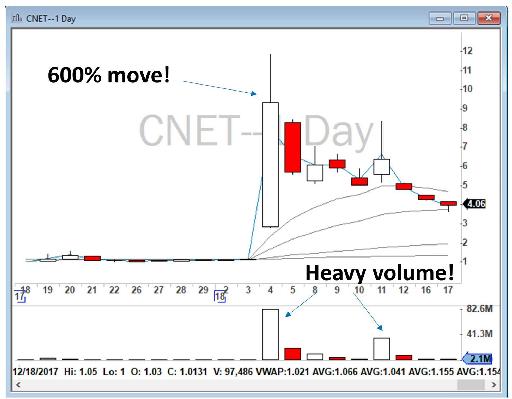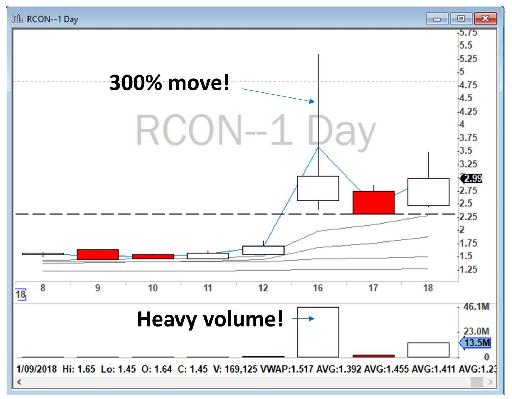Float and Market Cap
Before explaining the three categories, let me explain the definition of “float” and “market capitalization” or “market cap”. Float means the number of shares available for trading. Market cap is the total market value of all of a company's shares. It is calculated by multiplying a company’s float by the current market price of one share. For example, as of May 13, 2018, Apple Inc. has the greatest market capitalization at $927.86 billion, assuming a price of $188.59 per share. Apple is considered a “mega cap” stock as it has issued 4.92 billion shares as of May 13, 2018. These stocks usually don’t move much during the day because they require significant volume and money to be traded, so Apple shares might on average change by only one or two dollars each day. They are not very volatile, and therefore day traders don’t like trading them. Day traders look for volatility.
On the other hand, there are some stocks that have a very low float. For example, Cesca Therapeutics Inc. (ticker: KOOL) has only a 1.2-million-share float. This means that the supply of shares of KOOL is low, and therefore a large demand can very quickly move the price of the stock. Low float stocks can be volatile and move very fast. Most of the low float stocks are under $10 because they are early stage companies that, for the most part, are not profitable. They hope to grow, and by growing further, they issue more shares, raise more money from the public market, and slowly become mega cap stocks. These low float stocks are also called “small cap” or “micro-cap” stocks. Day traders love low float stocks. Now let’s look at those three categories.
The first category consists of low float stocks that are priced under $10. These stocks are extremely volatile, moving 10%, 20%, 100% or even 1,000% each day. Yes, there have been those kinds of moves! You must be careful with this category. Just as you can turn your $1,000 into $10,000 in a single trade, your $1,000 can just as easily turn into $10. Low float stocks under $10 are often highly manipulated and difficult to trade, and therefore only very experienced and highly equipped retail traders should trade these stocks. I personally rarely trade in them. If someone claims to have turned $1,000 into $10,000 in a month, and if it’s true, they must have traded this type of low float stock. No beginner or even intermediate trader can trade with such accuracy and efficiency. If novice traders tried trading low float stocks that are under $10, they would more likely turn their $1,000 into nothing in a matter of days.
When it comes to low float stocks, the Bull Flag and Fallen Angel Strategies — which I detail in Chapter 6 - work best. The other strategies in this book are not suitable for low float sub-$10 stocks.
You generally cannot sell short low float stocks. For short selling, you need to borrow shares from your broker, and it’s rare that a broker will lend you such volatile stocks. Even if your broker is willing to lend them to you, I strongly advise that you do not attempt to short sell them. They can easily surge and you will end up wiping out your account. You definitely can become a full-time profitable day trader without short selling risky stocks, so leave that to the Wall Street professionals.
Trading low float stocks is very difficult for the new trader. It is difficult to read the direction of their next move, and therefore it is very difficult to manage your risk while trading them. I discourage new traders from trading low float stocks. When the new trader is wrong, that loss can wipe out many gains.
The second category is medium float stocks which are often in the range of $10 to $100. These stocks have medium floats of around 20 million to 500 million shares. Many of my strategies explained in this book work well on these stocks, especially the VWAP and ABCD Pattern. Medium float stocks that are more expensive than $100 per share are often not popular among retail day traders, and I myself avoid them. You usually cannot buy many shares of them because of their high price.
The third category of stocks for trading is mega cap stocks like Apple, Alibaba, Yahoo, Microsoft, and Home Depot. These are well established companies that usually have over 500 million in public shares available for trading, and their stocks are traded in millions of shares every day. As you may guess, these stocks move only when institutional traders, investment banks, and hedge funds are buying or selling large positions. Retail traders like us, who typically trade 100 to 1,000 shares, usually cannot move the price of these stocks. Retail traders should avoid them unless there is a good fundamental catalyst for them. From the strategies set forth in Chapter 6, similar to medium float stocks, VWAP and ABCD Strategies usually work well on these stocks. Do not forget though, unless there is a fundamental catalyst, these stocks are being heavily traded by computers and high frequency traders and are not suitable for retail day trading.
The table below summarizes these categories:
| Float |
Price Range |
My Favorite Strategy (Chapter 6) |
| Low float |
Under $10 |
Bull Flag and Fallen Angel |
| Medium float (20 to 500 million) |
$10-$100 |
All, mostly VWAP and ORB |
| Large float |
Usually +$20 |
All, mostly VWAP |
Low float stocks are extremely volatile and difficult to trade. These stocks move really fast and because they are lower priced, their moves result in a more significant percentage change in your position. For example, when you trade a stock at $1 per share, every 1 cent tick to the upside or downside represents a 1% fluctuation in your position, while when you trade a stock at $40 per share, a move of one cent represents only a 0.025% fluctuation. Therefore, it is extremely more difficult to manage the risk involved in your trading while you are in a position in low float stocks.
Traders often call these low float stocks “runners” or, when they review them in the pre-market, “former runners”. This basically means that if they get the volume, these stocks can move significantly intraday. For example, Figure 3.4 shows the daily chart of Recon Technology, Ltd. (ticker: RCON), a stock with a float of only 11.4 million shares. As you can see, most of the time its stock is not being traded and it has a very low average daily volume. But on January 9, 2018, when important news about the company was released, the stock traded from $2 to above $5.50 (an almost 300% move intraday) with heavy volume. A similar example can also be seen in this Figure 3.4, the daily chart of Chinanet Online Holdings Inc. (ticker: CNET) with a float of 7.6 million shares. When CNET was the subject of positive news because of the growth in cryptocurrency, its stock moved from $2 to almost $12, an approximate move of over 600%.


Figure 3.4 - Former runners CNET and RCON.
One main source of inconsistency in the results of new traders is that they actually trade various types of stocks and yet get different results. A new trader will lose big on low float stocks, and then they will win small on medium float stocks. They will then again make a good trade on a low float stock and win big. That is why their portfolio often fluctuates up and down without any meaningful direction, but gradually, and at times not so gradually, their capital usually shrinks.
I strongly advise traders to avoid trading low float stocks at the beginning of their career and instead focus on developing their skill in trading medium float stocks. Based on my experience, trading and losing on low float stocks is the number one reason new traders blow up their accounts.
Table of contents
- DISCLAIMER:
- Table of Contents
- Chapter 1: Introduction
- Chapter 2: The Trading Tools and Platform
- Chapter 3: Building Your Trading Watchlist
- Chapter 4: Support and Resistance Levels
- Chapter 5: Price Action, Candlesticks and Trade Management
- Chapter 6: Advanced Day Trading Strategies
- Chapter 7: Risk and Account Management
- Chapter 8: Conclusion and Final Words
- Glossary